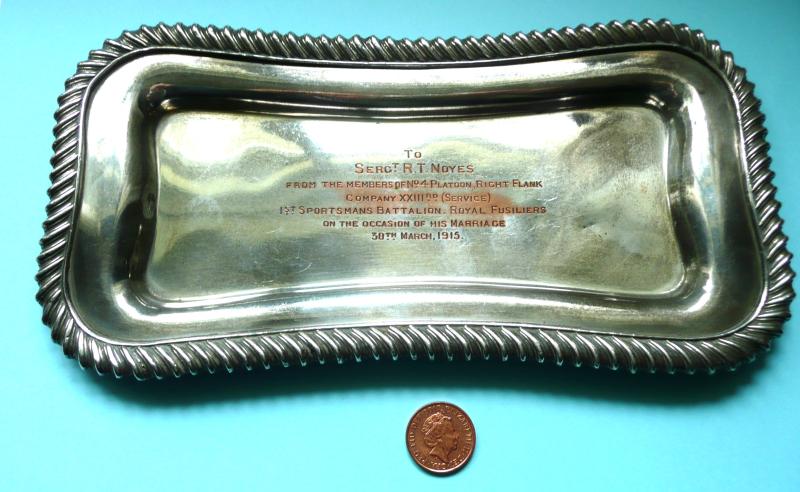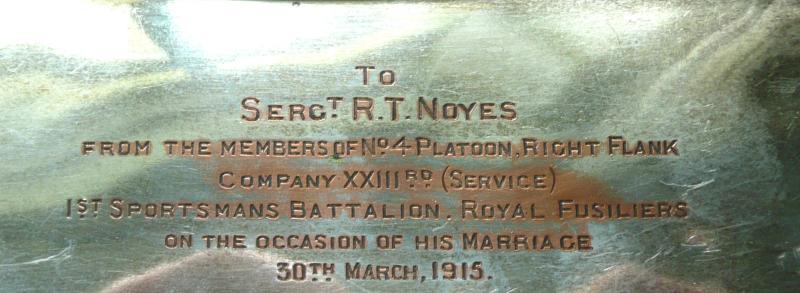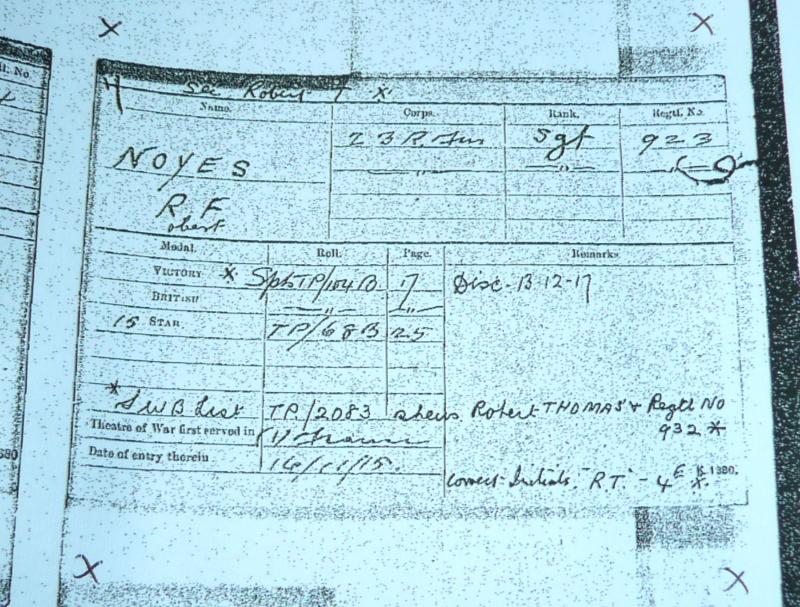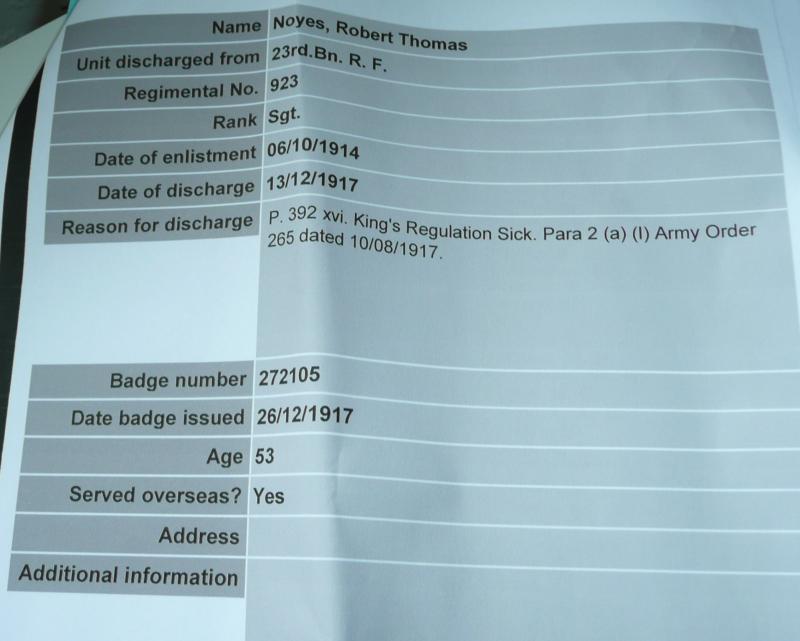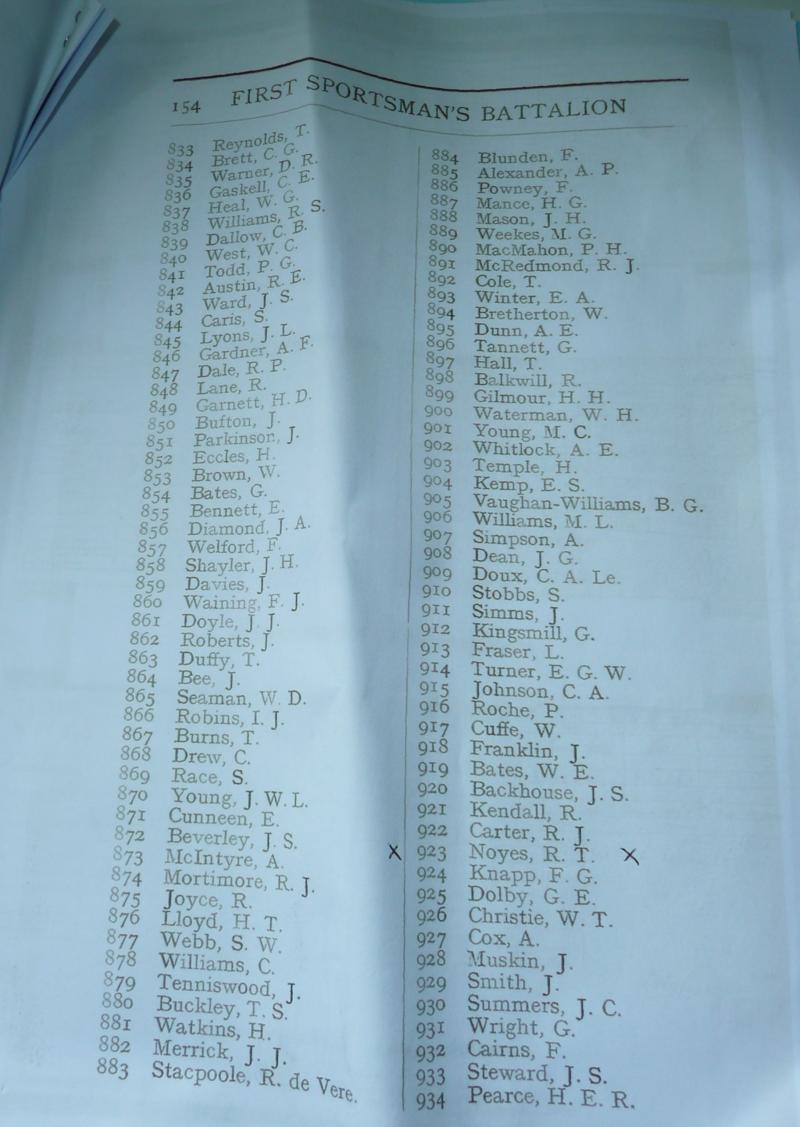WW1 Small Presentation Nickel or Silver Plated Tray - To Sergeant R T Noyes - 1st Sportsmans Battalion, The Royal Fusiliers (Born in Canada) and served with the Gordon Relief Expedition to Khartoum - Presumably as one of the Canadian Boatmen contingent
Engraved in upright capitals as follows:
" To / Sergt R.T. Noyes / From the Members of No 4 Platoon Right Flank / Company XXIIIrd (Service / 1st Sportsmans Battalion, Royal Fusiliers / On the occasion of his marriage / 30th March 1915"
With a raised decorative rope border, in unmarked silver plate or nickel plated in good condition except base metal is showing through in the area of the engraving from over-cleaning. Circa 22cms long and 11.5cms wide.
No 923 R T Noyes appears on the roll for the 1st Sportsman Battalion (copy of relevant page to be provided). He has two conflicting Medal Index Card (MIC) entries, one shows him as Sergeant and entitled to a 1914-15 trio, and confirms his christian name as 'Robert', the other gives his intials as R F but notes this needs to be corrected to 'R T' for Robert Thomas. It also confirms entered France on 14th November 1915 and that he was entitled to a Silver War Badge (SWB) but that the roll for this incorrectly states his service number as 932 (classic transposition error). On my CD version of the Silver War badge Register, his number is correctly shown as 923, and that he enlisted on 6th October 1914, and was honourably discharged sick on 13th December 1917 at the age of 53, and entitled to SWB number 272105.
On the Great War Forum I found an enquiry about him dated 2005, which states:
"Does the Battalion History give any information regarding R T Noyes, who was noted as being "an all round sport". Born in Winnipeg (Canada) and was with the Gordon Relief Expedition to Khartoum. Known as 'Canada' and was a 'brilliant raconteur and a great traveller, and was one of the most popular men in the Battalion". This is certainly borne out by his item, his wedding gift from the men of No 4 Platoon.
Approximately 392 Canadian boatmen received the Egypt medal for the Nile campaign in 1884.
The Canadian Encyclopedia gives a good account of the Canadians on The Nile:
'Garnet Wolseley had been assigned to Canada in 1861. From May to August 1870, he recruited 400 voyageurs (including 100 Haudenosaunee) to transport British troops and Canadian militia through 1,000 km of rivers, lakes and portages in response to the Red River Resistance. Wolseley’s Sudan mission would be similar in that he planned to move troops to Khartoum in a flotilla of boats up the Nile River.
In a message to the Canadian governor general, the Marquess of Lansdowne, Wolseley requested 300 Indigenous voyageurs from Caughnawaga (Kahnawake), Saint-Régis and Manitoba. Canadian prime minister Sir John A. Macdonald demanded that they serve as part of the British service and be paid by Britain.
There was an overwhelming response to newspaper advertisements that offered $30 to $40 per month plus expenses. In total, 379 boatmen were recruited for the expedition (Accordintg to Gordon's, there were 392). Canadian Lieutenant-Colonel Frederick Denison, who had served in the Fenian Raids and Red River Resistance, was appointed to lead the contingent. He was joined by four other Canadian militia officers, a medical officer and hospital sergeant, and a priest.
The voyageurs who met in Montreal in September 1884 comprised English and French Canadians and more than 100 Métis, Mohawk and Haudenosaunee. Most were experienced boatsmen, but many were lumbermen and others seeking adventure.
The voyageurs arrived in Alexandria on 7 October 1884 and took a train to Asyut, passing Cairo on the way. Waiting for them were the 9-m-long wooden whaling boats that they would use to transport about 5,000 troops and supplies. The boats had to travel 2,300 km south against the strong Nile current. The whalers were chained to steamboats and towed on the journey’s first leg. On 26 October, they arrived at the British garrison at Wadi Halfa. The steamboats could take them no farther.
Six-men crews rowed from sunrise to sunset. In shallow sections, they had to push the boats forward with long poles. Rapids forced men to either wade while pulling the heavy boats with ropes or undertake laborious portages. Accompanying the flotilla was a camel caravan of 1,800 British soldiers. It carried supplies, helped with portages, and offered protection from Mahdi.
In January, the voyageurs’ enlistments expired and most opted to return to Canada. They were welcomed in Ottawa with a celebratory meal and parade. Meanwhile, at Korti, Wolseley sent the caravan south. Those who had re-enlisted (about 85 in number) embarked on the Nile’s long loop east, south, and then back west to reunite with the caravan. Progress was slowed by unexpected rapids. On 17 January, the caravan was attacked at Abu Klea. The British troops defeated the attacking Mahdi but suffered 380 casualties.
On 26 January, a force of 50,000 Mahdi took Khartoum. Thousands of slain bodies lay on the streets and Gordon’s severed head was displayed on a pike. The flotilla arrived two days later.
On 10 February, the British troops fought a large force of Mahdi near Kirbekan. While the voyageurs stayed with the boats, Denison joined in the battle. The British were victorious, inflicting heavy casualties on the Mahdi force. Between 200 and 700 Mahdi died during the battle, compared to 12 British soldiers. The British force was then ordered to retreat to Egypt. As this meant running the river, the skills of the Canadian boatmen were crucial, particularly in sections with dangerous rapids. The flotilla reached Wolseley at Korti on 8 March and the Canadians left for Alexandria soon after. On 17 April, they sailed for England; their expedition was over.'
The 16 Canadians who died on the expedition are memorialized in the Peace Tower in Ottawa. A grateful British Commons and House of Lords passed a vote of thanks for the Canadians’ service. All volunteers received a special medal commemorating the expedition, with a Kirbekan bar for those who reached Khartoum.
From the enquiry discovered above, Noyes could well have been one of these Canadian Boatmen he may have been entitled to some interesting pre war medals. worthy of further research. Any information welcome.
I will only ship to a UK address unless by prior arrangement.
K49
Code: 67590
110.00 GBP

